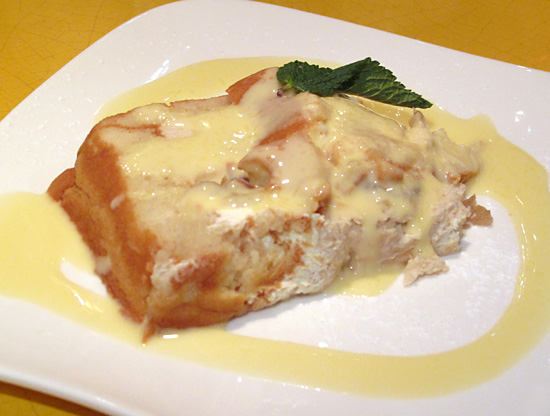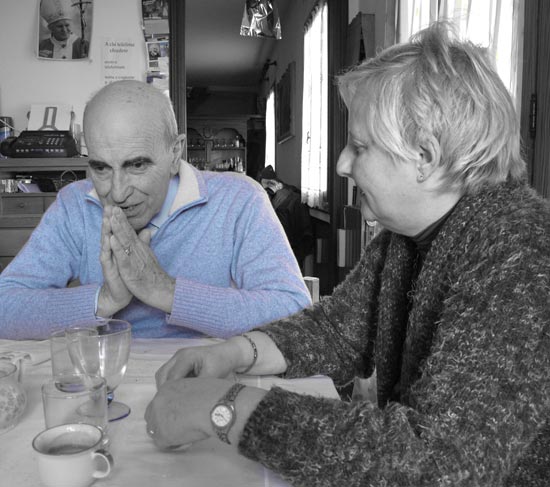
by Maureen | Mar 1, 2010 | Cheese, Featured Articles, Food!, Incredible Locations, Journal, Meals, People, Photos, Sanremo
Dinner the night before was followed by a long lunch the next day. Renata and Angelo, who live in a town within walking distance from Sanremo, were having some friends over on Sunday and I was invited to come along. So gracious! It’s a real treasure to have people open their doors and ask me to join them in their homes.
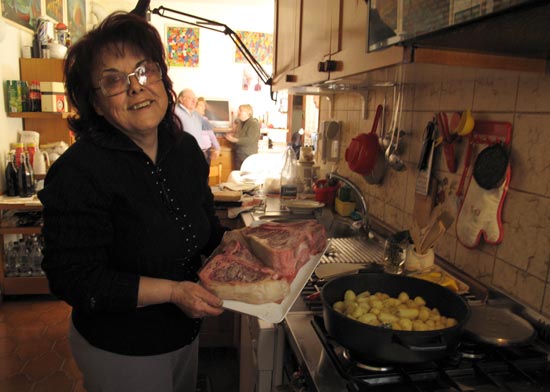
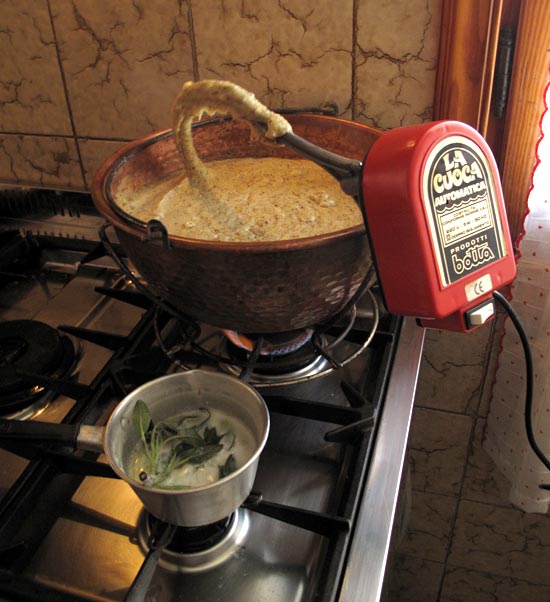
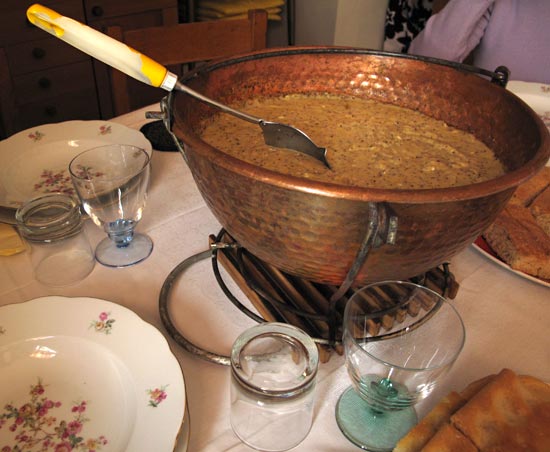
By a little before one o’clock, 8 people had clustered in the kitchen and around the dining table. Renata and Angelo had been cooking all day for us and piled the table high:
- Genovese focaccia – plain, with oil.
- Sardenara – Ligurian specialty focaccia with tomato sauce,
anchovies, olives, oregano and garlic.
- Carciofi Impanati Friti – breaded, deep-fried, small young artichokes.
- Maiale Cicioli – breaded, deep-fried pieces of pig fat.
- Patate – little baby potatoes, roasted with olive oil.
- Polenta Taragna Concia – a regional style of polenta with ground buckwheat and 1 kilo of cheese. It cooked over the stove in a copper kettle for more than an hour, with a motorized stirring paddle to mix it and keep it from sticking.
- T-Bone Steaks – the thickest t-bones I’ve ever seen were grilled outside ’til rare. The meat was cut away from the bone, then sliced and served.
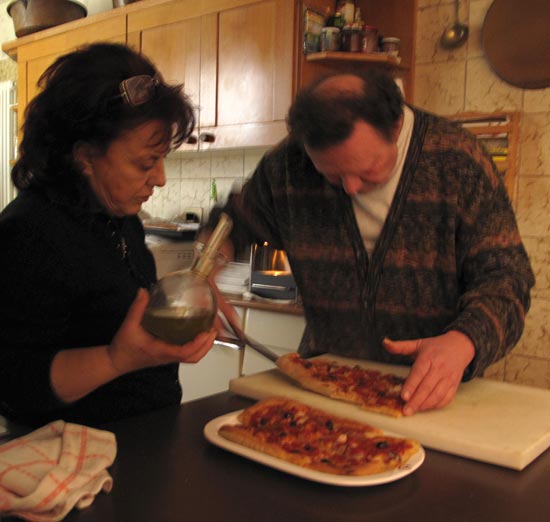
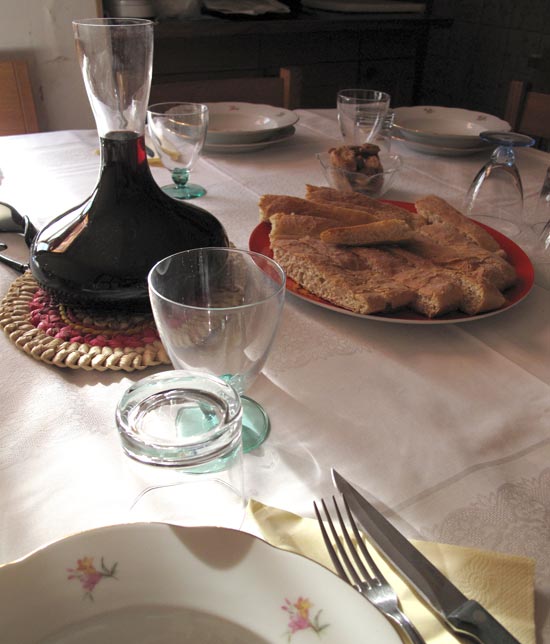
The sweets at the end of the meal included:
- Bugie – (which means “lies”) crispy, fried, sugar-dusted twists of dough.
- Nutella-topped sweet buns
- Baked Pears – Angelo got up from the table several hours into the afternoon and prepared baked pears by crushing amaretto cookies, mixing them with chocolate and liqueur, and pouring this blend onto the pears before quick baking.
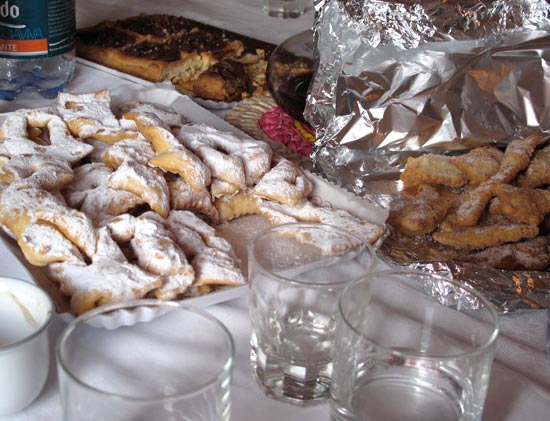
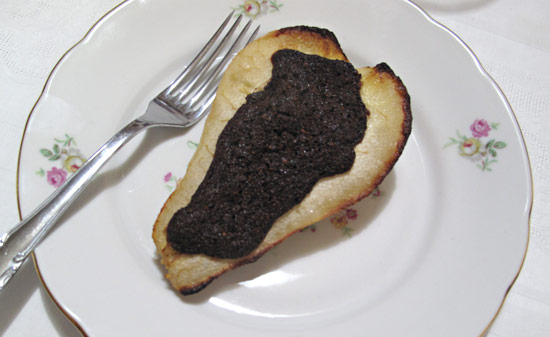
The food went around. The home-bottled chianti, extra-proof, flowed, as did the conversation. I understood most of it and jumped in when I had something to add. Though I had shot photos of Renata in the kitchen when I first arrived (feeling comfortable since we’d had dinner together the night before), I kept my camera tucked away for the first couple hours of the meal. These people didn’t know me and I didn’t want to be rude.
To lubricate the conversation, we had begun with the chianti, then moved on to champagne, grappa, rum and caffé. Time was passing and everyone was loosening up. I was treated to a display of classic Italian hand gestures, mannerisms and animated speech. So theatrical, you would have thought it had been scripted. Eventually, my camera came back out and I had fun snagging images as the hours ticked by.
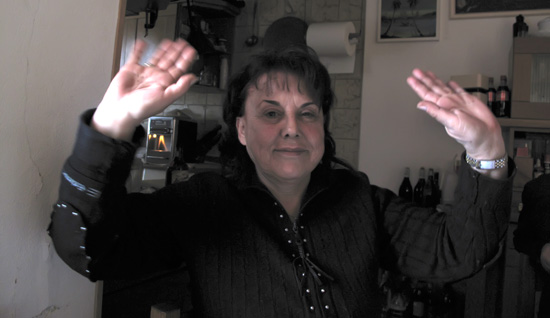
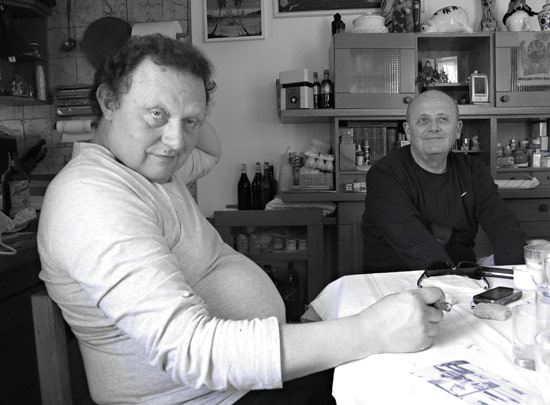
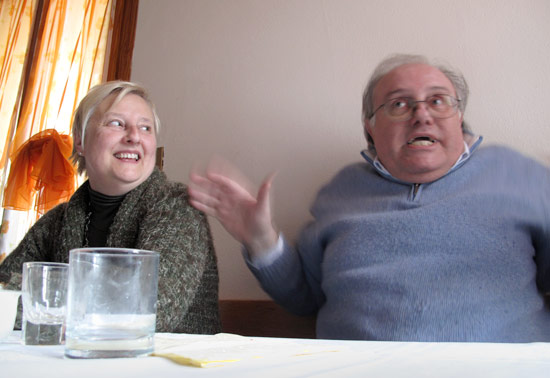

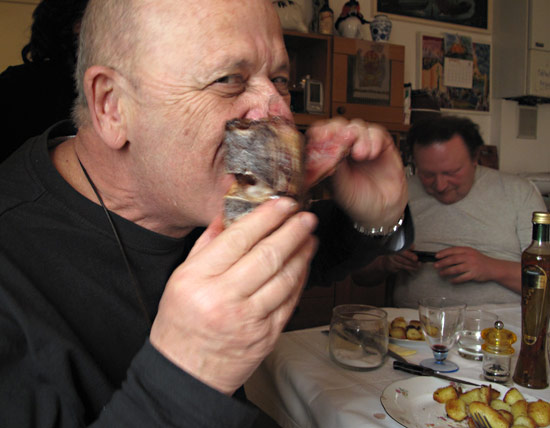
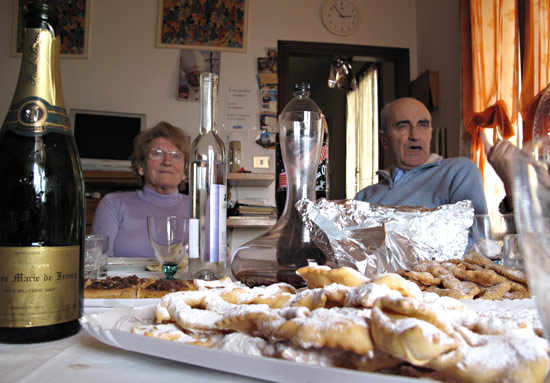
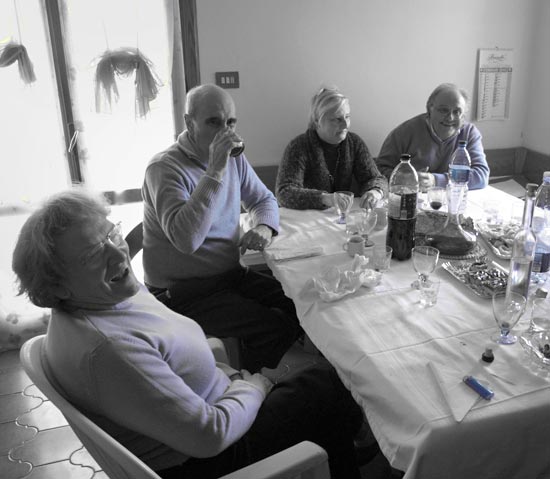

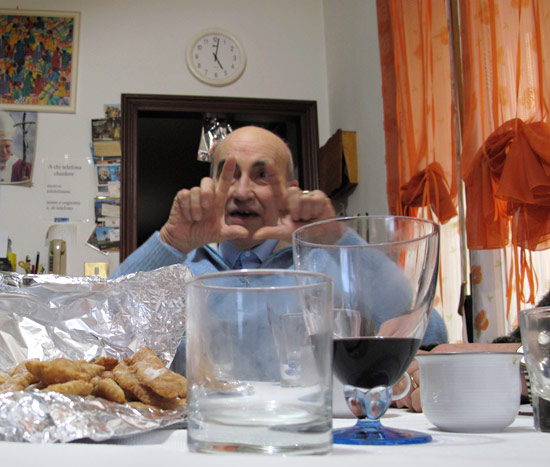
The first part of the day had been blue-sky serene, the kind of day that brings the crowds to the Ligurian* seaside. As we passed the afternoon in lively discussion at the table, the sky had darkened, a wind picked up and waves were crashing at Renata and Angelo’s bulkhead. It was time to go home at close to 7:00.
*Liguria is the “Italian Riviera”, that northern region of Italy that includes Cinque Terre at its southeastern end and arcs from there northwesterly to France.
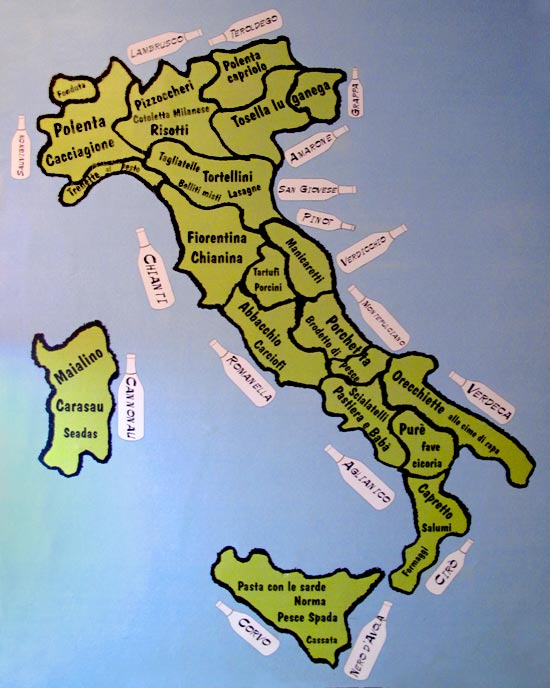
by Maureen | Feb 28, 2010 | Cheese, Food!, Introspection, Journal
In reading my blog posts about what I’m eating here, I hope that you’ll realize how much broader the Italian culinary range is than the stereotypical American concept of “Italian Food”. There is SO much more than pizza, spaghetti, lasagna and ravioli. “Fettucine Alfredo” is a figment of the American imagination, and I’ve been told emphatically, “NEVER serve tomato sauce on spaghetti!” Italians have laughed at that idea.
You can travel a mere 100 kilometers and encounter regional, traditional foods you couldn’t have found at your last stop. There are foods unique to specific communities!
As an example, depending on the region, the starch base will be different. You may encounter polenta, pasta (of a shape specific to that region), rice (risotto), focaccia or other bread. Wines, meats, cheeses and seasonings all vary by region.
For instance, in my last visits to Sanremo, I was treated to:
- Sardenara – a focaccia bread with tomato sauce, anchovies, garlic and olives (no cheese), specific to Liguria.
- “Branda Cugnon” – A delicious mash of salted, dried white fish (cod?), potato, parsley, olive oil and garlic. (Don’t ask about the bawdy origin of the name.)
- Rabbit with Sauce of Pureéd Rabbit Livers – A secret, family recipe in which the rabbit livers are pureéd with other ingredients (I’m not supposed to tell) until they become a thick, pink slurry. The sauce is then stirred onto the hot, stewed rabbit parts, and is “cooked” only from the residual heat.
- Polenta Taragna Concia – Yellow, coarse polenta (cornmeal) with ground buckwheat and a kilo of cheese stirred and cooked into it over the stove for an hour.
The next time you want to go out for “Italian Food”, stretch beyond what you’re familiar with and either go to a restaurant that offers more authentically prepared foods, or pick something off the menu other than your tried-and-true favorite. Order something you can’t identify. I do it all the time!
Below is a map that I saw on the wall at Ristorante Re Enzo in Bologna. It mentions just a few of the noted food and wine specialties for each region.


by Maureen | Feb 15, 2010 | Cheese, Featured Articles, Food!, Journal, Meals, People, Photos
We got together to celebrate Anaïs’s 24th birthday with traditional Milanese apperitivi at an “art bar” in town. Several of us women from Italian classes get together outside of class for chats, bike rides and travel. Anaïs is one of them.
She’s from Cannes, France, and 3 of her friends drove over, (bringing her kitty with them) to spend her birthday weekend. There were 10 of us together around the table, representing 5 countries: 4 French, 1 Portuguese, 1 Turkish, 2 Italian, 2 American, ranging in age from 24 to 40-ish… and me. The language changed depending on the speaker and the listener.
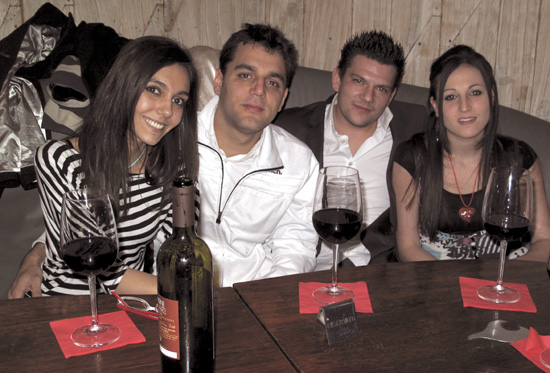
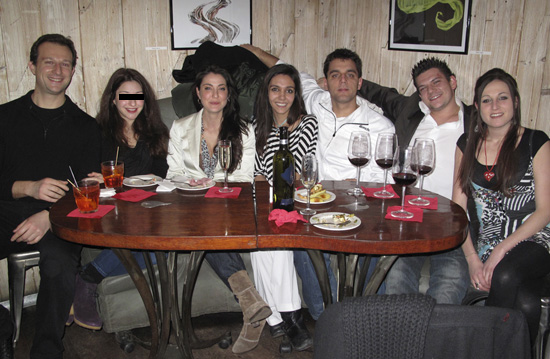
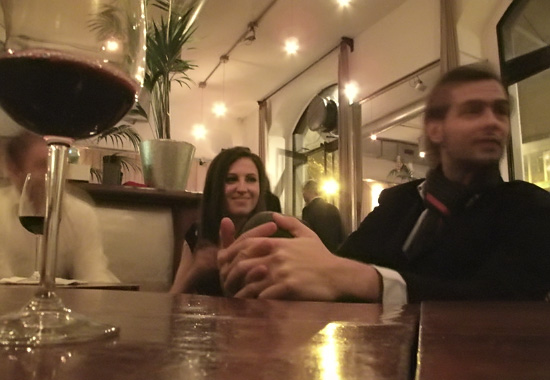
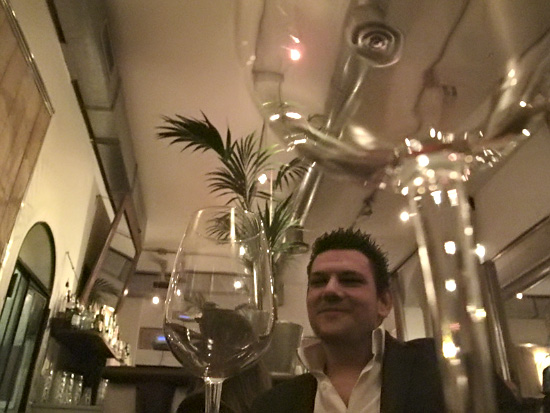
The Milanese apperitivi tradition allows you to go to just about any restaurant in town, buy one drink for 7 – 9 euro and eat as much as you want from the buffet of appetizers: pizza and foccacia squares, bruschetta, pasta, french fries (!), sliced meats, cheeses, risotto, mini-tarts. A better apperitivi offering will include such things as steamed mussels, veggie sticks, interesting salads, and other foods that are lower carb and more artfully prepared.
After our apperitivi, several of us went out for dinner at 11:30 p.m. to a Mexican restaurant, while the others went to the disco.
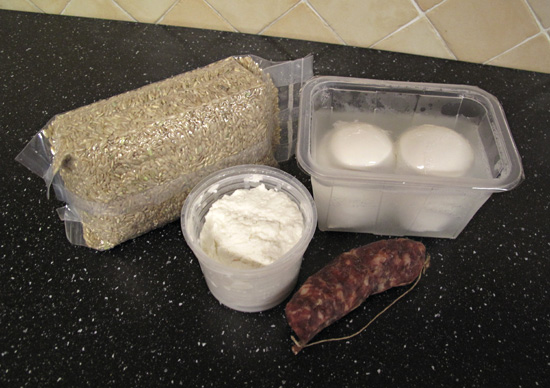
by Maureen | Feb 13, 2010 | Canals, Cheese, Discoveries, Featured Articles, Food!, Journal, Photos, Shopping & Markets
Saturday. Clear blue skies. About 50 degrees. Yes!
I headed down the canal on my bike, but decided on a change of scenery and followed the path I learned about from Angelo, my surprise tour guide in mid-January. The one lane road wound though small towns and rice fields. I found my way back to the same old “cascina” (large, formerly-fortified farm) that Angelo had shown me. The farm store had been closed that time before, and though they were closed again, a young woman came out of the house and welcomed me into the shop.
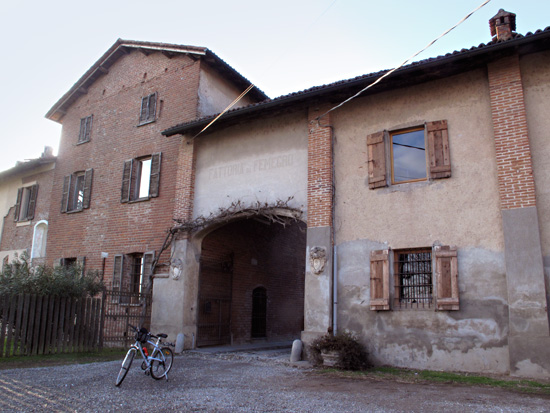
“What do you recommend?”, I asked her. She pointed out all of their own farm-produced foods and I selected fresh ricotta, fresh mozzarella, brown rice and salami. What could be better?!

I found a way to secure the little bundle on my bike and continued my ride. There was a woman on a pink scooter. A lawn hosting 4 peacocks. An old tile roof warming 3 black cats. 1 Woman on a bike. Swelling buds on the trees. And a stop to say “hello” to Padre Pio at his shrine in Zibido San Giacomo. What a day!
Gauging the position of the sun and the remaining daylight and warmth, I went as far as Noviglio then turned around to head north back to home.
The very first thing upon coming in the door was to open the ricotta and mozzarella and have a taste. OH…MY! That fresh ricotta was better than most ice cream. I simply got myself a spoon and started eating it. Wow. Delicious. And the salami was good, too.
I’m really liking this. Go for a bike ride and, not far out of the city, pick up home grown rice and fresh ricotta cheese. (This is so unlike my previous life experience.)
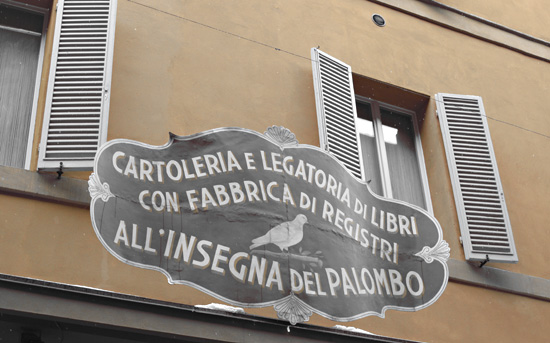
by Maureen | Feb 1, 2010 | Bologna, Cheese, Discoveries, Featured Articles, Food!, Graphics, Incredible Locations, Journal, Photo of the Day, Photos, Shopping & Markets
As a designer and artist, being here in Italy is a pilgrimage to the home of all the motifs, patterns and visual elements I’ve studied and heard of all my life. At times I’m overwhelmed, excited by the visually lush surroundings.
The storefronts and shop windows are delicious with their old-world signage and embellishments.
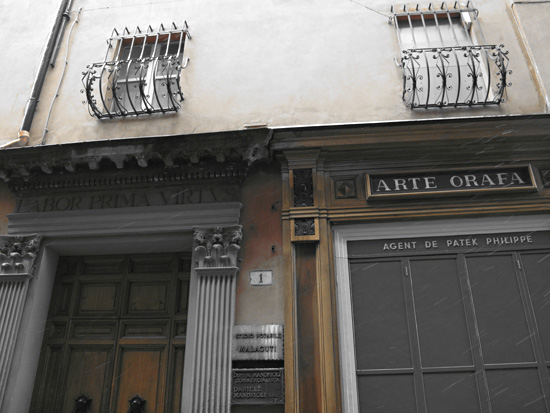

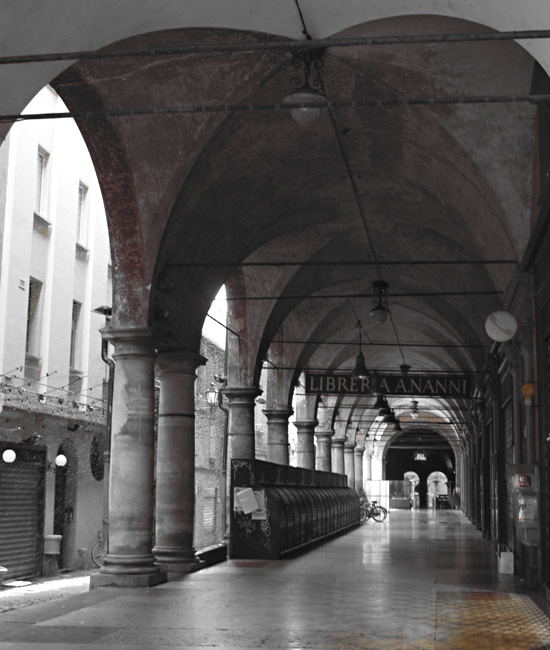
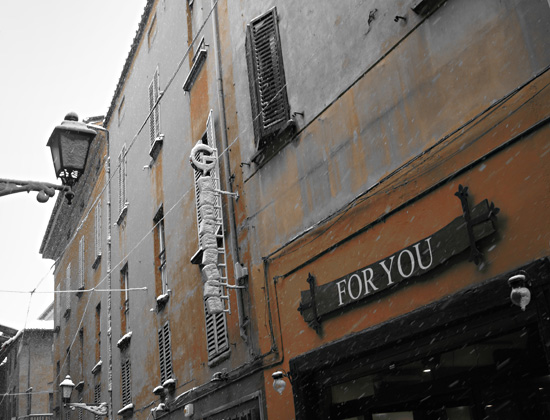
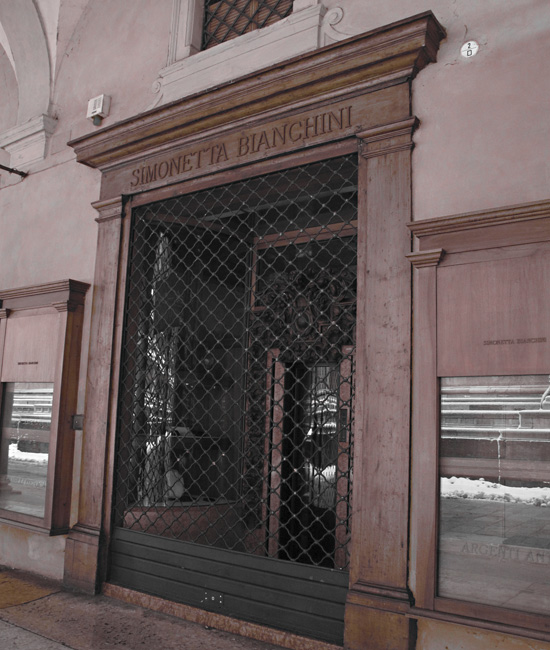
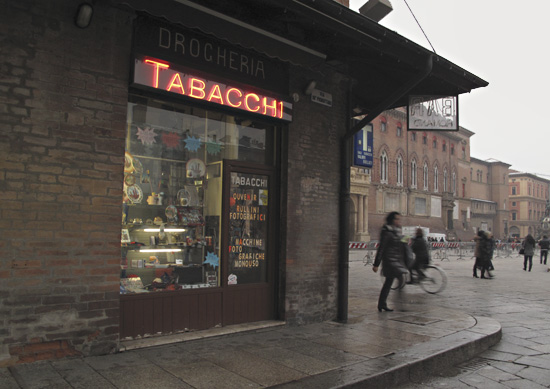
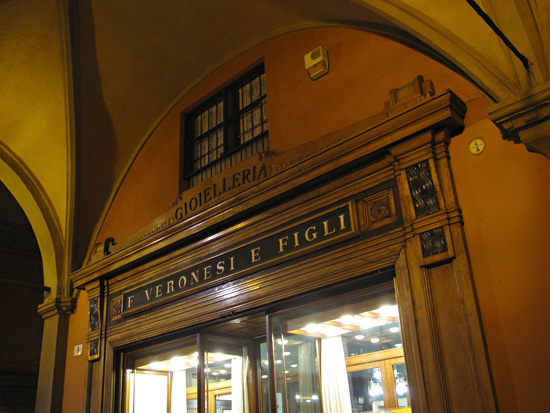
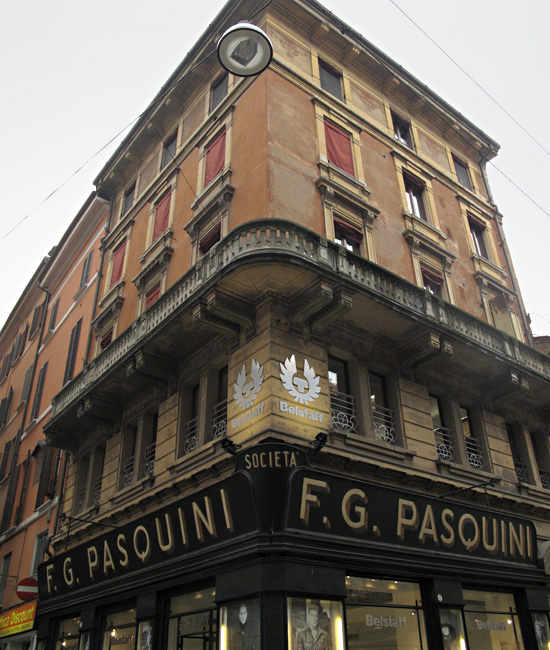
This is a contemporary storefront for a high-end clothing store. All of the furnishings are made of corrugated box stock, as well as the “chandeliers” at the ceiling.
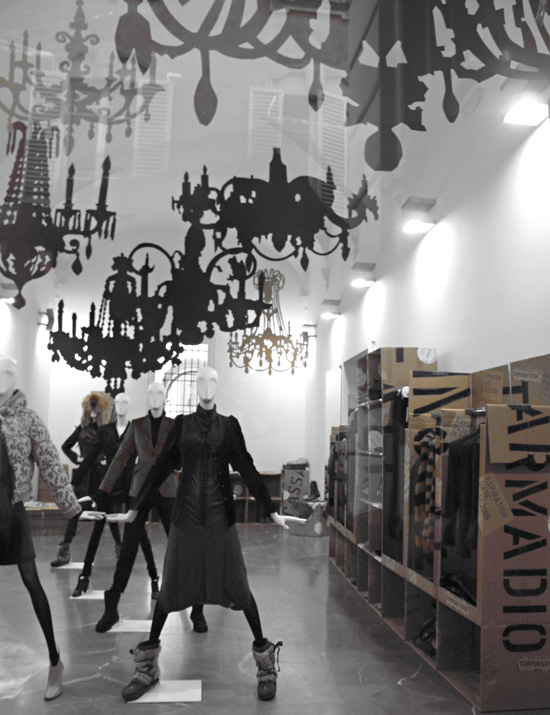
THIS is the place to buy Bolognese classic foods! The meats! The cheeses! The 40 euro ($60) 8 ounce bottles of balsamic vinegar! Mmm.
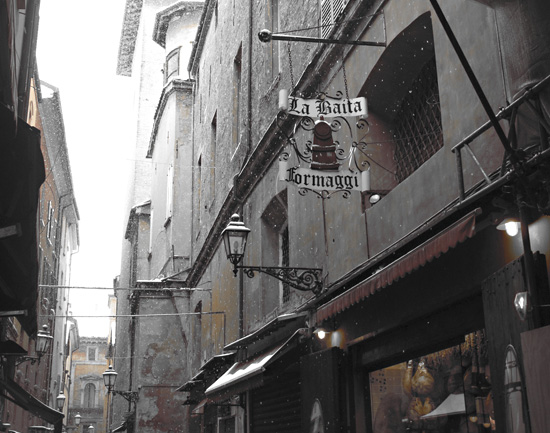
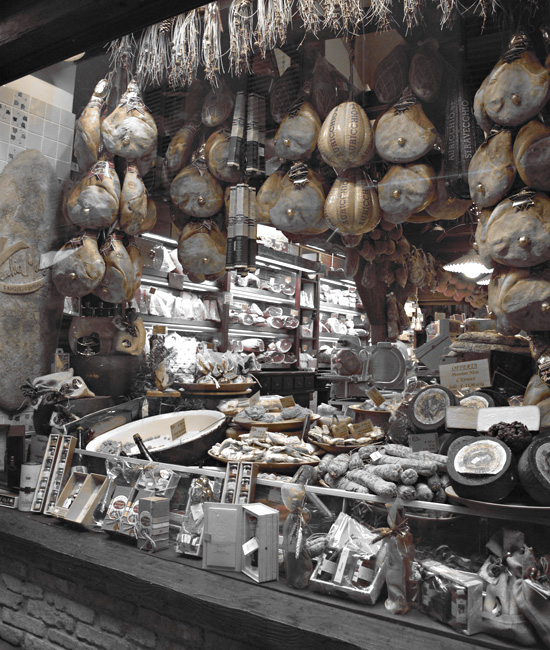
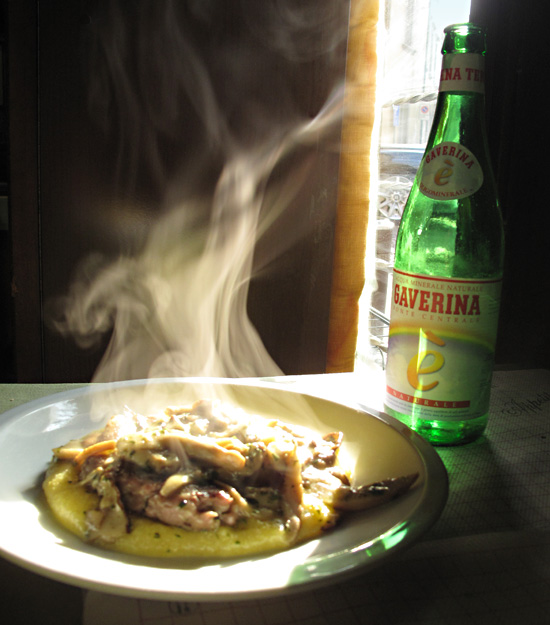
by Maureen | Feb 1, 2010 | Bergamo, Cheese, Featured Articles, Food!, Incredible Locations, Introspection, Journal, Meals, People, Photos
From my journal entry, 23 January. Bergamo.
Bergamo is beautiful and reminds me of San Gimignano in Tuscany. I’m on in the “Alta Cittá”, the high city up on the hill within the old fortress walls. Towers, stone, weathered doors, cobbles. I’m sitting in a little trattoria, “Trattoria 3 Torri”, the restaurant of the 3 towers.
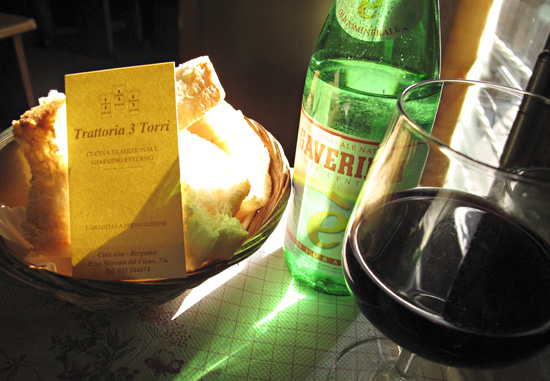
I was standing outside looking at the menu, and the proprietor, Casimiro, came to the door and smiled out at me. A smile goes a long way with me; to be in a foreign country and have someone reach out in that small way seals my decision of where to eat, shop, explore. A geniune smile is the universal entree to first connection.
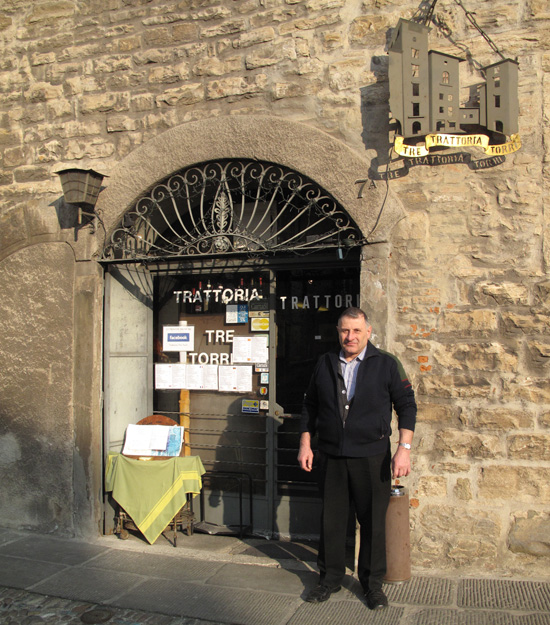
I’m sitting under vaulted stone ceilings eating a lovely polenta with sausage and porcini mushrooms with a hint of gravy. The sun is shining in onto my table, the first time I’ve seen and felt it in ages (more than a month?). As others enter the restaurant, he gives them a menu in their “madre lingua”, mother tongue. He gave me the menu in Italian. (That’s a compliment.)

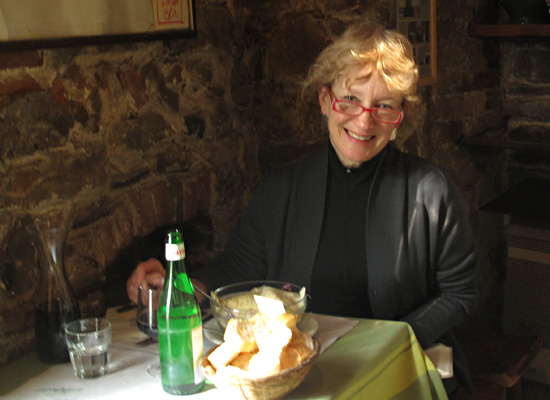
It’s now 2:00 p.m. Midday is a good time to have my main meal, come in and get warm sitting next to the heater with the sun in my eyes. And January is a perfect time to be exploring these places that would attract the tourists. It’s quiet and uncrowded. It’s much more relaxing.
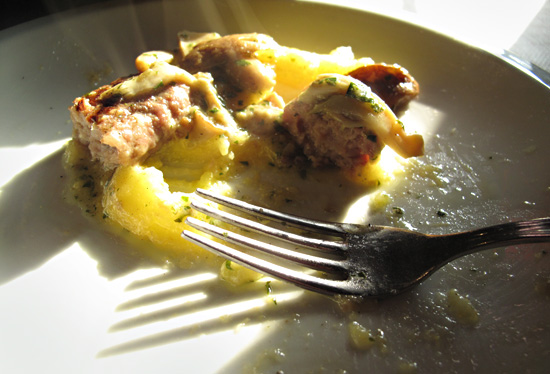
My heart and head are SO pulled by this history that reaches back to 1400 and further. To touch surfaces touched for centuries, to stride stone ways that have been stepped upon for so long. We simply do not have such history in the U.S. We do not have the remaining evidence to lay our hands on. Perhaps one day I might become inured to this, but at this point it makes me gasp repeatedly in disbelief. I cannot conceive of what I’m in the presence of.
The visual and physical richness here charges me. It excites me.
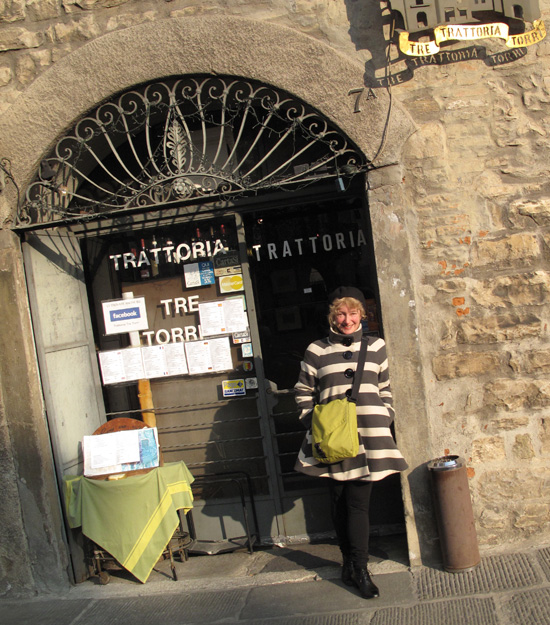
Trattoria 3 Torri • Cittá Alta, Bergamo
Piazza Mercato del Fieno, 7/a • Tel: 035-244474
Facebook: Trattoria Tre Torri
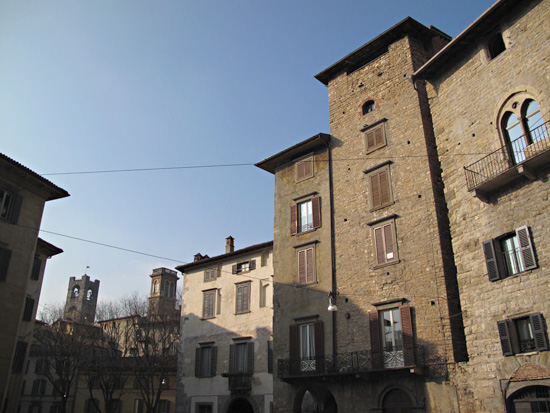
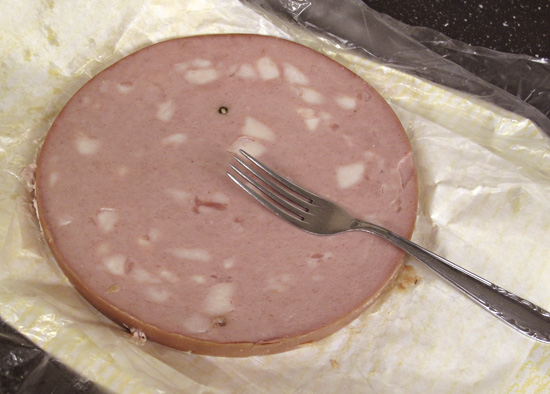
by Maureen | Jan 17, 2010 | Cheese, Discoveries, Featured Articles, Food!, Journal, Meals, Quips
This could easily be the next big thing. The new, chic food. All it would take is some hip New York restaurant to put it on the menu and spread the word. Or a Guru T.V. Show Chef to rave about it: The All-American Grilled Mortadella Burger.

You could cut a half inch thick slab of Mortadella into burger sized rounds, put those pieces on the grill with some wood chips for a little smokiness, then cook ’em hot ’til those little cubes of fat are translucent and dripping onto the coals. Flip those slabs and cook ’em some more.
You could go “classic” burger, with a white bun, cheddar cheese, tomato, lettuce, ketchup and yellow mustard. Or elevate the burger to gourmet on an artisan bun with some perfect Italian cheese, spicy/sweet mustard from the Trentino-Alto Adige region and a slice of tomato. Arugula instead of lettuce?
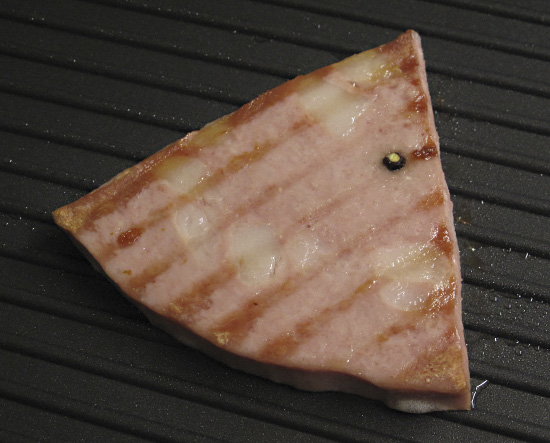
I usually see Mortadella as a sausage over 8 inches wide, scattered with lovely little cubes of fat throughout the ground “meat”. Peppercorns and pistachios are here and there throughout. Don’t call it “baloney”, although that’s the closest equivalent in the U.S.
Mortadella has origins in the town of Bologna and has been made for hundreds of years by very resourceful pig farmers unwilling to waste any part of the animal. Hmm. What does that say about what ends up inside the sausage casing? Do we want to know? Salt, peppercorns, seasonings, wine and pistachios are added to the 7:3 ratio of pork to fat. The Mortadella is cooked, then cooled.
For further information, check out this site: lifeinitaly.com
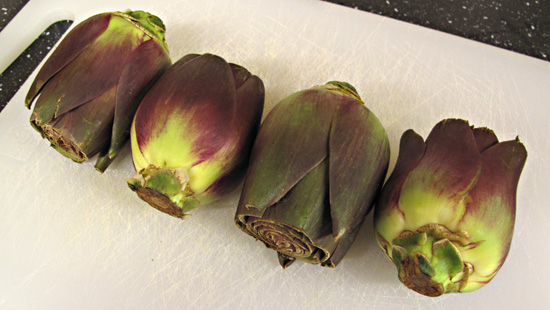
by Maureen | Jan 9, 2010 | Cheese, Christmas & New Year's Eve, Discoveries, Featured Articles, Food!, Journal, Meals, Photos, Shopping & Markets
Have you ever wondered about the first ones to eat something new that they hadn’t encountered before? IS it edible? What PART is edible? Should it be eaten RAW or COOKED? What part do you DISCARD? What part is most DELICIOUS? How is it best PREPARED? What should it be eaten WITH?
Traveling to and cooking in a foreign country is much like being a “primitive man” asking all those questions about newly encountered food items. But at least when you walk into a grocery store or step up to a market stall, someone has done the preselection for you and you’re not out in the woods trying to discern edibility. If it’s in the store, SOME part of it must be edible.
For the last couple of months I’ve been seeing these very small, young, almost-flower-like artichoke heads in the street markets and grocery stores. Very beautiful, but what do they DO with them?! I had no idea, and passed them up, regretfully. I had eaten marinated artichokes scooped out of little jars. Had steamed softball-sized heads and eaten them, leaf-by-leaf dipping the ends in butter. And I’ve eaten that sinfully fat-laden, hot dip with artichoke hearts, cheese, mayo and who knows what else. But I’d never done much else with them or seen them offered other ways. Yes, I’m sure the recipes and methods are out there, but the ones I just mentioned seem to be the across-the-board standards for eating artichokes.
On the evening of New Year’s Day, I was out walking around the Duomo and decided to have dinner out. I picked one of the few restaurants that were open, perused the menu and decided I HAD to have “Insalata di Carciofi Crudi” – Salad of Raw Artichokes! I ordered a “Pizza di Quatro Formaggi” – a four cheese pizza – to go with the salad, but that was secondary in my mind.
What arrived at my table was a bowl with paper thin shavings of very young, tender artichokes, including about an inch of the stem. They had been drizzled with a “fruttato” – “fruity” – extra virgin olive oil and lemon juice, sprinkled with salt and freshly ground pepper and tossed together with some thinly sliced grana cheese. Wow! Delicious! Simple, fresh in the middle of winter and quite a surprise. NOW I knew what could be done with those flowery artichokes.
Tonight, at the grocery store, I didn’t pass them up. They sold some untrimmed with thorny tips and 8 inches of stem, and they sold trimmed, packaged groups of 4. I considered the prices and how much would be thrown away from either and bought those that had been trimmed.
Usually, I would “just wing it” and approximate what I had tasted on New Year’s Day, but I decided to look online to see if there were any guidelines to follow. In doing so I found a handy Italian cooking website: Buonissimo.org. (Sorry. It’s all in Italian.) The recipe I found was what I had surmised and described above.

I removed the outer, half dozen tougher leaves and trimmed both ends to freshen them up. Then I cut the flower heads in half.
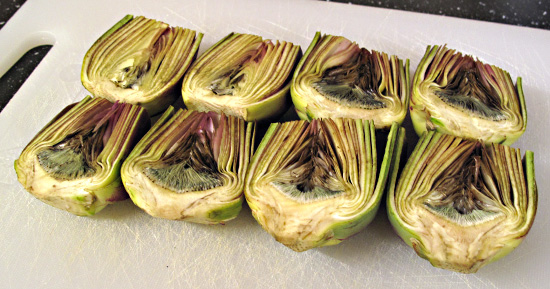
Since I don’t have a mandolin slicer here, I used my best Shun Tomato Knife, sharp and serrated, and sliced the artichokes as thinly as I could. (I left the furry inner parts, figuring they hadn’t gotten prickly.) I put it all in a bowl with the grana padano cheese (a nutty, almost sweet, hard cheese similar to parmesan), abundant lemon juice and extra virgin olive oil. Shook a little sea salt and grated some fresh pepper then gave it a gentle tossing.
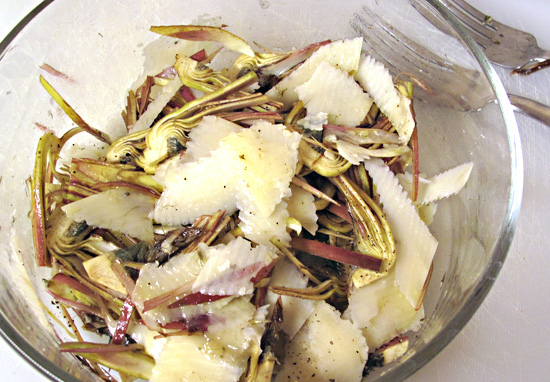
With my heaped serving of “Insalata di Carciofi Crudi”, I ate Norwegian, farm-raised salmon seasoned with Seattle’s Tom Douglas’ sweet/peppery Salmon Rub. The salad will become one of my new favorites. (If nothing else, it’s certainly good for the roughage!) But are the artichokian flowers available in the States?!
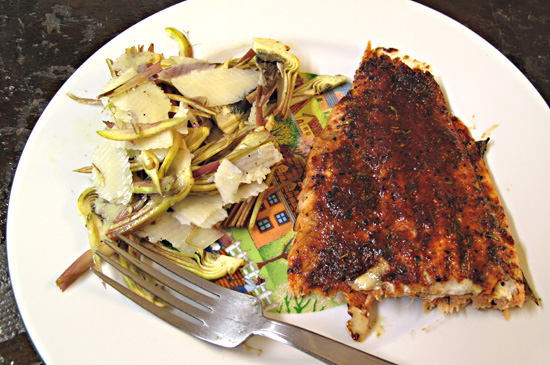
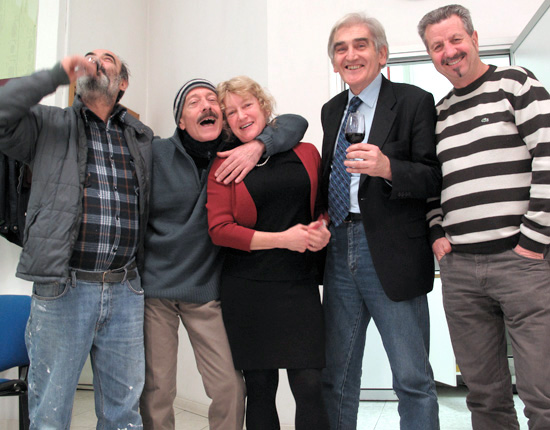
by Maureen | Jan 9, 2010 | Cheese, Discoveries, Featured Articles, Food!, Journal, Meals, People, Photos
“Maureen, there are a few of us having some appetizers and wine. Why don’t you come join us?”
It was Mario, the regional director for ONAV, the National Organization of Wine Tasters. We had met a few times at their wine-tasting events: Prosecco-tasting, Barbera- and Barolo-tasting, Champagne-tasting. I’m going to attend their 9 week course in wine-tasting, beginning in February. Any of their gatherings, formal or casual, are opportunities to sample some diverse and very special wines… and meet new people.
I took the Metro across town, walked two blocks and entered the ONAV classroom full of tables and chairs. These four guys – Michele, Vicenzo (giving me a choke-hold), Mario, Carlo – sat at a table cluttered with meats, breads, wine, oil and sweets. (The three are long-time friends of Mario, not with ONAV.) As you can see, it wasn’t a stuffy group.

We sampled a number of wines and also enjoyed a tasting of Extra Virgin Olive Oil from the San Gimignano region.
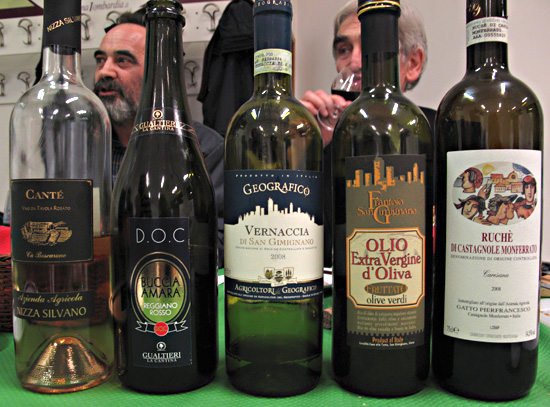
I didn’t realize until afterwards that I should have gotten a photo of Carlo in his striped sweater, with Vicenzo in his striped hat and me in my striped coat. It would have been a highly-visual photo. (Vicenzo asked if I know of any American women I could set him up with.)
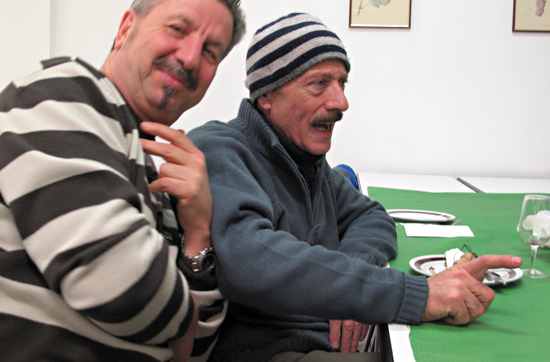
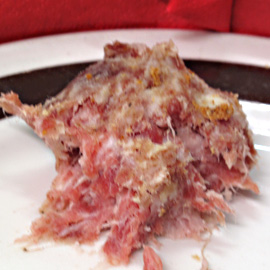 The table bore mortadella, salami and a raw, seasoned meat/fat combo that Mario simply peeled the casing off of and spread on bread. (I know the photo’s out of focus, but at least it gives you an idea of the meat’s appearance.) We ate from a large rustic loaf, a potato loaf, and Sicilian bread sticks and rounds.
The table bore mortadella, salami and a raw, seasoned meat/fat combo that Mario simply peeled the casing off of and spread on bread. (I know the photo’s out of focus, but at least it gives you an idea of the meat’s appearance.) We ate from a large rustic loaf, a potato loaf, and Sicilian bread sticks and rounds.
There was a bone-white spread of pecorino and ricotta cheeses pureéd together. And a special treat was the “Lardo di Colonnata”, raw, salted, herbed pig lard, aged at least six months and served as thin slices on bread. Mmm, good!
(I’ve become quite fond of eating raw meats and moldy cheeses.)
We drank a sparkling red, a white, a rosé. The most “startling” wine was the deep red Ruché (Roo-kay); I had never tasted anything like it with its very distinct flavor. (I’ll have a better vocabulary to describe it AFTER I take the class.) You could ask for Ruché* at your local specialty wine shop, but its very low production makes it unlikely that you’ll find any.
Our little post meal sweets were dried figs and apricots from Sicily, and almond pastilles that are frequently offered as favors at weddings. (In the States, too.)
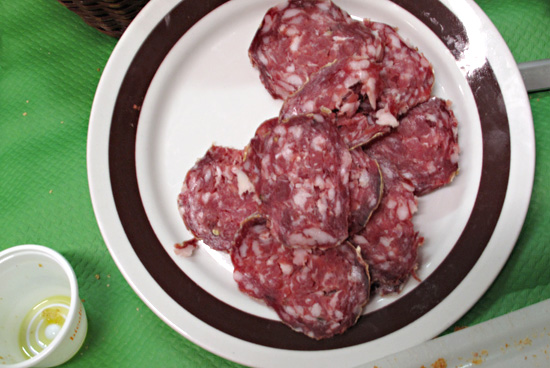
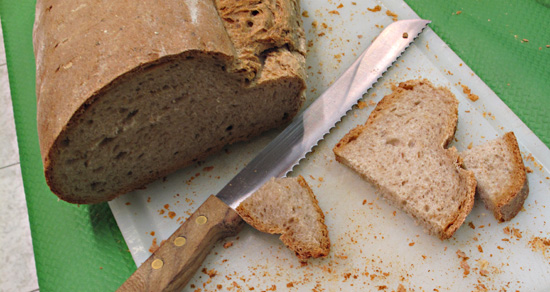
The very special end-note to the evening was a wonderful Passito di Pantelleria from the tiny little Island of Pantelleria, Italy, between Sicily and Tunisia. Passito, made from dried and shriveled moscato grapes, is a gorgeous amber color and a drink that requires every sip to be savored. I couldn’t keep my nose out of the glass; the scent was divine.
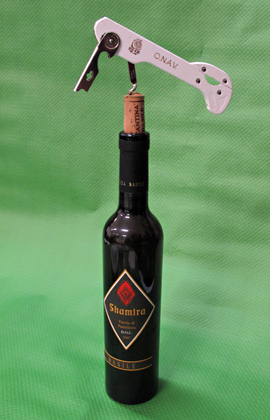
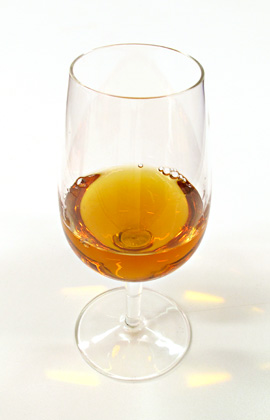
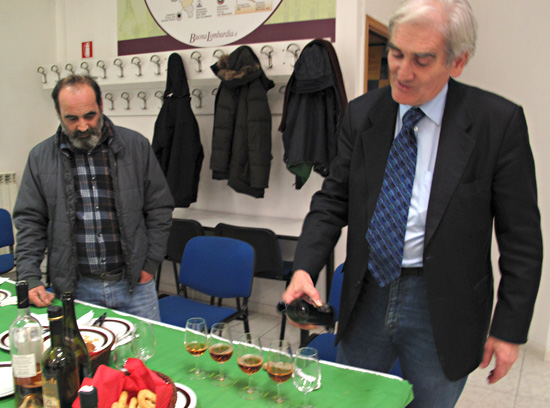
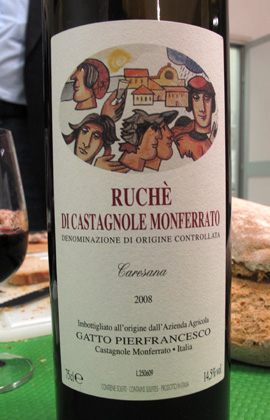
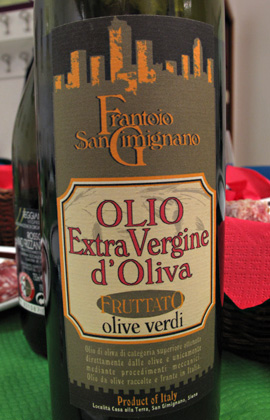
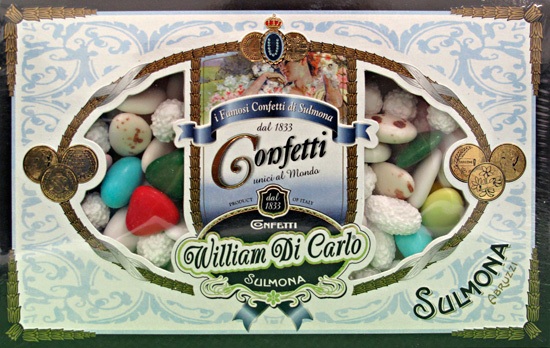
Below, on the right, is a bag of the not-fully-dried, shriveled moscato grapes used for making passito. You can eat them much like raisins.
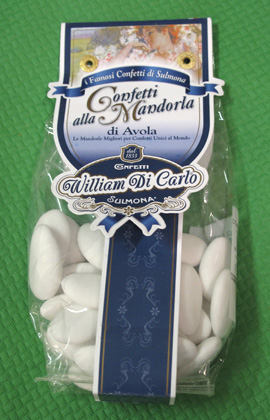
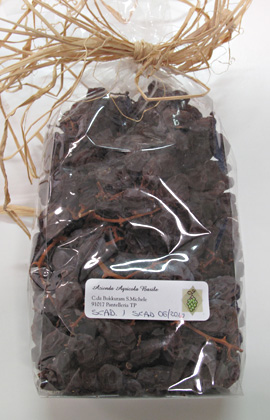
Ruché (from Wikipedia):
Ruché is a red Italian wine grape variety from the Piedmont region. It is largely used in making Ruché di Castagnole Monferrato, a small production red varietal winewhich was granted Denominazione di Origine Controllata (DOC) status by presidential decree on October 22, 1987. The current DOC recognized area of production for the wine, covers only about 100 acres [[40 hectares) of vines around the villages of Castagnole Monferrato, Refrancore, Grana, Montemagno, Viarigi, Scurzolengo andPortacomaro.[1] Ruché di Castagnole Monferrato is, therefore, one of the lowest production varietal wines in Italy. The grape is also grown to some extent in the neighboring province of Alessandria.
There is some debate about the origins of the Ruché grape. One theory is that the varietal is indigenous to the hills northeast of the town of Asti. Another theory is that the grape is a local variation on a French import. It has been grown in the area for at least one hundred years but has only recently been marketed and consumed outside of the immediate vicinity of its production. Ruché di Castagnole Monferrato tends to be medium bodied with notes of pepper and wild berries and floral aromason the nose.[2] The wine is often characterized by moderate acidity and soft tannins. In the Piedmont region it is often paired with slow-cooked beef, northern Italian cheeses and mushrooms.
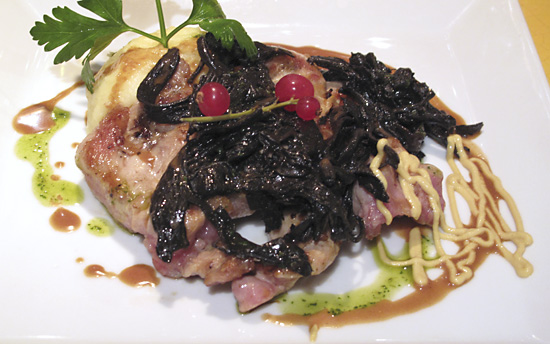
by Maureen | Dec 27, 2009 | Cheese, Christmas & New Year's Eve, Featured Articles, Food!, Incredible Locations, Journal, Meals, Paris, Photos
Journal Entry:
“8:00 P.M. After a day at the Louvre.
I’ve just eaten the most sumptuous dinner at a little restaurant/bar, “Louis Vins”. The food had me melting at the first bite.
Le Louis Vins, 9 Rue de la Montagne Ste Geneviève, 75005 Paris, France
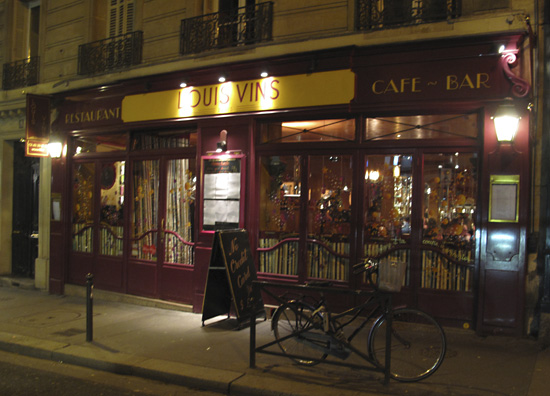
I ordered the warm goat cheese salad, which had rounds of cheese crusted with pistachios (?) and grilled, served on a dressed bed of mixed greens. The warm cheese was lovely.
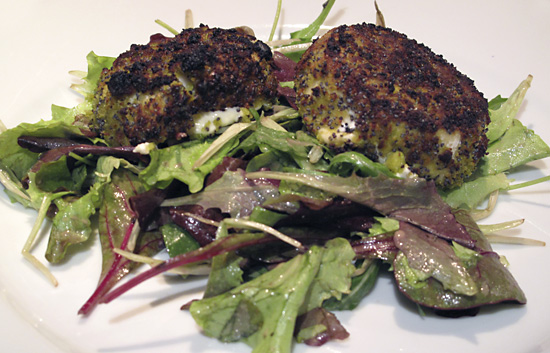
For my main course, I absolutely savored the “Araignée of Porc with Trompettes de la Mort” mushrooms. The drizzles of sauces had me relishing every bite as the flavors lingered. Fabulous! I’m drinking a nice red, 2006 Crozes Hermitage.

(My language skills translated “Trompettes de la Mort” as “Trumpets of Death”, but when I researched the name, it came up as “Horns of Plenty”. Hmm. So much for my language skills.)
…Oh! They just brought my “Cold Creamy Cake Candied Chestnuts”, drizzled with some sort of heavenly sauce! Out-of-this-world divine! My mouth is in a dream.
